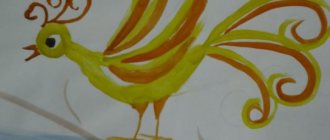Lesson summary on the topic “Autumn color of leaves of trees and shrubs”
LESSON SUMMARY ON THE TOPIC “AUTUMN COLOR OF LEAVES OF TREES AND SHRUBS. LEAF FALL"
Author - compiler:
Grigorieva Irina Evgenievna, teacher of additional education at the MBU DO “Station of Young People” in the city of Vyazma, Smolensk region.
Goals:
introduce children to the autumn phenomenon - leaf fall, the reasons for leaf fall; teach children to identify plant leaves with autumn colors; nurturing love for the nature of the native land, nurturing aesthetic feelings.
Equipment:
magnifying glasses
,
colored pencils, coloring book “Leaves of Trees and Shrubs”, cards “What kind of trees are these?”
Visual aids:
herbarium of leaves of trees and shrubs with autumn color; maple branch;
Progress of the lesson:
I.Organizational moment.
II . 1. Report the topic and objectives of the lesson.
Hello guys! Today we will start our lesson with a riddle.
Yellow wings of aspen, birch, Red wings of ash, oak and rose, They circle and rustle in the air. It's autumn... (Leaf fall)
So, the topic of our lesson: “Autumn color of trees and shrubs. Leaf fall"
2. Story with demonstration.
What color are the leaves on trees and shrubs in summer? What color are the leaves in autumn? Why do you think?
The fact is that chlorophyll gives the leaf its green color. It is easily destroyed under the influence of light, and it is formed again in the plant (but only in the light). In summer, the formation of chlorophyll keeps pace with its destruction, and the leaf remains green all the time. There are other coloring substances in leaves besides chlorophyll.
Experience (scheme)
Green leaves + alcohol = leaves will turn pale, alcohol will turn green;
Green alcohol + gasoline = gasoline will turn green, alcohol will turn yellow.
From experience it is clear that in the leaves, in addition to green particles, there are also particles of a different color, but in the summer there is a lot of light and there are more green particles, they drown out the others. In autumn, leaf activity begins to fade. There is little light, the formation of chlorophyll lags behind destruction. Less and less “green paint” remains in the foliage, and yellow coloring substances become more and more noticeable; the leaf turns yellow.
Different species of trees and shrubs acquire different autumn colors. Let's look at a herbarium of leaves of trees and shrubs with autumn color.
Have you noticed that some trees and shrubs are only yellow in autumn? These are birch, linden, ash, oak, and willow. But the leaves of maple and aspen can be yellow and red. The leaves of rowan, euonymus, and barberry are colored red in autumn. Along with this, some remain green for a very long time (lilac, alder).
The fastest trees to change color are maples, lindens, bird cherry, aspen, ash, and hazel. Later rowan, viburnum, elderberry, willow.
In cloudy, damp autumn, the leaves remain green longer, because... chlorophyll is actively destroyed in the light, and other coloring substances are formed.
What other autumn phenomenon associated with plant life can be observed?
Leaf fall. Trees prepare for leaf fall in advance, even in the summer.
Let's take a closer look at the maple branch. Look, a bud is formed in the axil of the leaf petiole, and reserves of nutrients are deposited in the wood cells. Spring will come and, thanks to these reserves, a young shoot with leaves will develop from the bud. Pay attention to the maple leaf. Use a magnifying glass to examine the base of the leaf petiole. Here, by autumn, a cork layer forms. It’s like a partition separating the leaf petiole from the branch. Therefore, in the fall, leaves leave their native tree without much difficulty at the slightest breath of wind.
Increased leaf fall begins after the first frost. It occurs differently not only in different breeds, but even in the same breed. In city gardens and parks, birch leaves fall in a shorter time than in forests. Young trees shed their leaves later than older trees. Sick trees are more likely to lose leaves than healthy ones.
Why do trees and shrubs shed their leaves in autumn?
It turns out there are several reasons:
1.First of all, leaf fall saves plants from drying out. Trees need a lot of water, but in winter there is none. Imagine that a birch tree evaporates up to 7 tons of water during the warm months. If the trees did not shed their leaves, they would die from drought. Coniferous trees evaporate much less moisture than deciduous trees. Pine and spruce evaporate water so economically that they are not afraid of “winter water famine.”
2. In addition, if the trees did not shed their leaves, a large amount of snow would accumulate on their branches. The branches broke under its weight.
3. During the spring and summer period, a huge amount of harmful substances accumulate in the leaves of plants. Which they get rid of during leaf fall.
3. Physical school
We, the autumn leaves, sat on the branches. The wind blew and they flew. We flew, we flew. And they sat down quietly on the ground. The wind came again. And he picked up all the leaves. He turned them over and around. And he lowered it to the ground.
(Children imitate the actions of the “leaves” in accordance with the text of the poem: they squat, fly around the room, sit quietly again, rise, spin and sit again.)
4. Autumn signs
Since ancient times, people have watched the leaves of trees and shrubs fall. Based on their observations, folk signs emerged:
1. If in autumn a leaf from a birch or oak tree falls uncleanly, expect a harsh winter.
2. Late leaf fall - for a harsh and long winter.
3.If the leaves on the trees turn yellow early in the summer, then it will be early autumn.
4. Premature leaf fall - for early winter.
5. If in the fall the leaves fall off the trees quickly, then expect a harsh winter.
6. Late leaf fall means a difficult year: the winter will be long and protracted.
7. If the leaves fall cleanly from the birch and aspen, then next year will be fruitful.
However, in Rus' they watched not only how and when leaf fall began, but also watched how a falling leaf lays on the ground:
1. If an autumn leaf lies face up on the ground, then the winter will be cold; inside out – warm; half face - the winter will be moderate, and cold and warmth will alternate.
2. If in the fall birch leaves begin to turn yellow from the top of the tree, then spring will be early, and if from below, it will be late.
5.Working with cards “What kind of trees are these?”
The leaves have fallen off. Find out what kind of trees are in front of you by their trunks and branches.
6.Coloring the coloring book “Leaves of Trees and Shrubs”
Here are coloring pages of leaves of trees and shrubs. Let's determine which plants they belong to. Now you should paint the leaves the color they are in autumn.
Coloring exhibition “Waltz of the Leaves”
III . Summing up the lesson.
"Autumn leaves"
Construct of joint educational activities
according to PM 02 Organization of various types of activities and communication of preschool children
Zabrodina Valeria Alekseevna
Date: 10/16/2019
DOW No.: 86
Group:
Senior (5-6 years old)
Educator:
Ivanova Ekaterina Vladimirovna, Leonova Vera Ivanovna
Head of practice:
Temereva Lyudmila Petrovna
Educational area:
artistic and aesthetic development
Type of OD:
drawing
Subject:
"Autumn leaves"
Forms
: frontal, individual
Target:
develop children's artistic creativity through drawing autumn leaves from life
Planned result:
Children show interest in drawing autumn leaves from life
Children are interested in visual arts
Children have a developed creative imagination
Children can draw autumn leaves from life, conveying their shape and color.
Children can draw autumn leaves from life with a brush.
Children can mix watercolor paints to create complex shades and convey autumn color
Children know how to correctly position a sheet of paper and draw on A4
| TASKS educational program |
| Educational : to cultivate interest in drawing autumn leaves from life Developmental: continue to develop children's interest in visual arts Educational: figurative: teach children to draw autumn leaves from life, conveying their shape and color technical: introduce drawing autumn leaves from life with a brush color: improve visual techniques (mix watercolors to obtain complex shades and convey autumn color) compositional: teach children to position the sheet correctly, draw on A4 |
Principles of preschool education (FSES DO):
building educational activities based on the individual characteristics of each child, in which the child himself becomes active in choosing the content of his education, becomes the subject of education;
assistance and cooperation of children and adults, recognition of the child as a full participant (subject) of educational relations;
supporting children's initiative in various activities;
formation of cognitive interests and cognitive actions of the child in various types of activities;
age adequacy of preschool education (compliance of conditions, requirements, methods with age and developmental characteristics);
Principles of training
: the principle of learning in the zone of proximal development, the principle of clarity, systematicity and consistency, the principle of consciousness, the principle of activity, the principle of accessibility.
Principles of education:
formation of a personal style of relationships with peers and teachers, creation of a positive emotional background and an atmosphere of emotional uplift, education through interaction.





